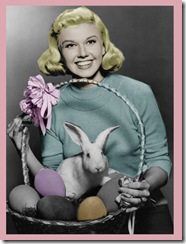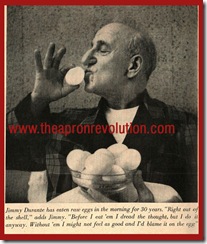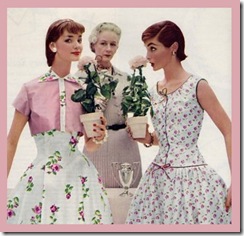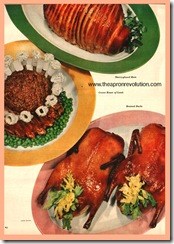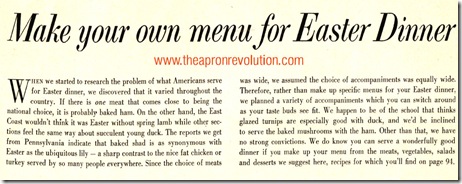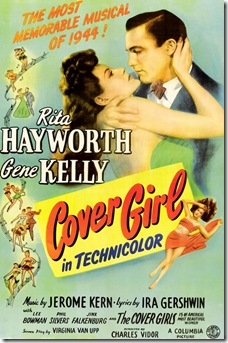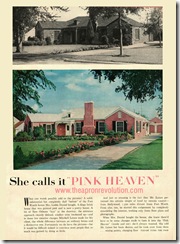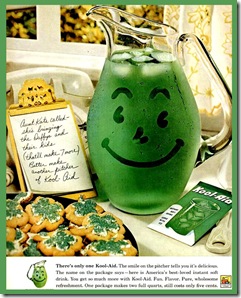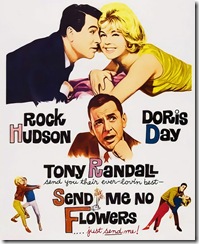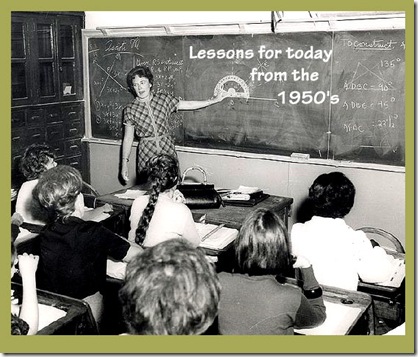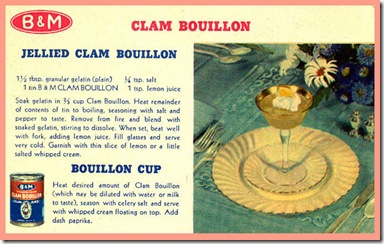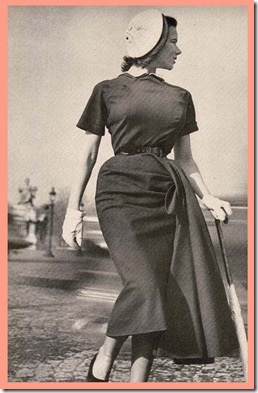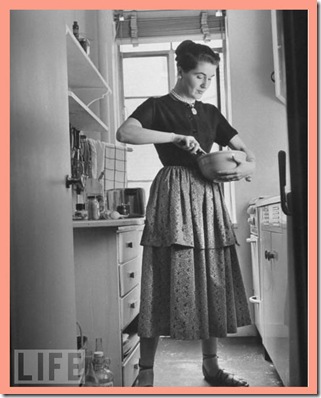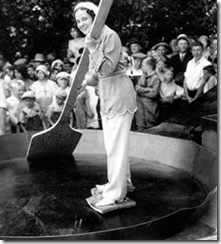 Today I thought we could talk about keeping drippings and fats. The lovely leftover from cooking meats is in fact kitchen gold and is a great low cost but high quality way to aid your kitchen endeavors.
Today I thought we could talk about keeping drippings and fats. The lovely leftover from cooking meats is in fact kitchen gold and is a great low cost but high quality way to aid your kitchen endeavors.
Keeping fat has long been the norm. It was only recently, after the First World War, that new products began to be made that would be an artificial version of such fats. But, even well into the 1960’s, saving fat was rather a normal household occurrence and jars and canisters existed solely for this purpose. And such a jar, rather bought our reused coffee tins or canning jars, often sat on the counter near the stove for easy access of pouring in new and taking out old with which to cook again.
Let’s look at some darling dripping and grease containers.
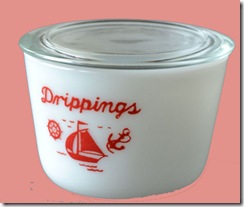 With my own love of sailboats, including having a red sailboat in my kitchen window, I would love this drippiings jar. And indeed it is for sale, but it is $54 and a bit out of my price range for something I can easily use a canning jar for. But, I may find one one day while at a tag sale.
With my own love of sailboats, including having a red sailboat in my kitchen window, I would love this drippiings jar. And indeed it is for sale, but it is $54 and a bit out of my price range for something I can easily use a canning jar for. But, I may find one one day while at a tag sale.
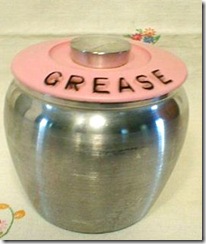 This jar seems to have been part of a set.
This jar seems to have been part of a set.
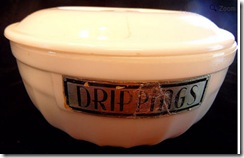 This lovely Anchor Hocking version is from the 1930’s. This version as well as the pink lidded can be found at Ruby Lane.
This lovely Anchor Hocking version is from the 1930’s. This version as well as the pink lidded can be found at Ruby Lane.
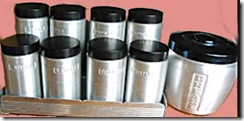 Here you can see that often a Grease/drippings jar was included in a canister set it was such the norm to keep fats and drippings.
Here you can see that often a Grease/drippings jar was included in a canister set it was such the norm to keep fats and drippings.
Storing and saving fats/grease/drippings is not hard. It is cost effective and really no trouble at all and your subsequent dishes will be the better for using such saved fats. You can strain them before storing and in fact some of the 40’s and 1950’s version of grease containers had a lift out strainer at the top, as seen here: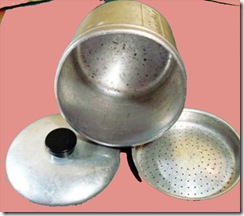
I had been using cheesecloth, but recently at my part time job, I was lucky enough to come into some paper coffee filters. The rules of the day dictate anything that hits the floor for a second gets tossed out. You would not want to even know the amount of stuff that simply gets tossed. But, being the odd little duck that I am, most at work now know to save any damaged or out of date food for me and my chickens. And I often find a use for most things that ‘hit the floor’ and are ready for trash. They make new grease holders with pouring spouts like this one which can be bought for $14 here.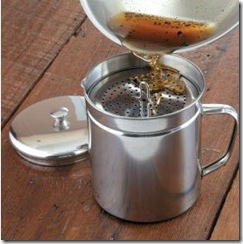 I am not affiliated with this nor do I get any money for it, but thought it’d be worth to share the link.
I am not affiliated with this nor do I get any money for it, but thought it’d be worth to share the link.
This is how I came into possession of a stack of large round paper coffee filters. They make straining easier because they are very fine and then you toss them away. But, I suppose one could consider that these white filters may very well contain bleach, I don’t know. When I have exhausted my supply I will simply return to cheesecloth. I keep a few specifically for the job and they get soaked in hot water and hand washed and hung to dry. Otherwise I find they get shredded in the laundry. But, the main point is to strain your drippings/fats. Any food stuff left in is what will become rancid and spoil your kitchen gold. However, with that said, my Bacon grease I do not strain. It contains little bits of the bacon and really I like it that way. It goes into the ice box, so no worries about rancidity. And it is my most oft used fat, so it gets replenished more. Some day, when I can have land, I will raise a pig a year and that lovely creature will provide for us all year. They say the only part of a pig you don’t use is the squeal. But, were I to raise one, maybe we could record its delightful little squeal as a cell phone ring or some such. One does hate waste so!
Back to drippings, the shelf life for fats I found by investigation seems to be 6 months in the ice box/fridge and 9 months in the freezer. I have almost no freezer space, so my precious freezer space is kept for other things. I simply decant mine in canning jars and put in the fridge. I usually keep some on the stove (Bacon fat usually) in a little container this time of the year. And during the warmer months in the ice box. My old house has an unheated kitchen so many foods can be left out in my kitchen that a more warmer heated kitchen may not be privy too.
When you store your fats in clear glass jars you can see that when they settle you have that lovely bit of congealed fat on top, that actually acts to preserve and seal out air form the drippings below. This is similar to the process of canning where one aims to restrict oxygen from the food, as in the case of sealing wax on top of jams and preserves or when the air is removed from a canning jar. Oxygen gives life to bacteria and restricting it allows food to last longer. Add Chemist and Scientist to the ongoing list of ‘jobs’ a Homemaker must master.
Often when I cook a big roast or chicken I let the fat and drippings congeal in the pan. If you are worried you can let this happen in the fridge, but I let it happen on the counter. I figure I use my fat in a hot state so it is reheated to a safe temp to kill any harmful bacteria. Also, as previously mentioned, my kitchen is quite cool in the winter months. After the drippings have congealed, you can see the layer of thick white fat on top. I will scoop this off as best I can and put in a jar separate from the drippings. Underneath you will see a lovely clear brown/yellow (depending on the meat) gelatin/Jell-O/jelly. You can pick it up in sections and like the old jell-0 commercials, ‘watch it wiggle’. I will take these “Jell-O” shots and put them in a glass jar separately. These are kept in the ice box and are added, as you would the mixed fat, to soups, stocks, etc. I find that this clear form of the drippings are good for soups, not making them greasy, and for dropping into rice while cooking, and on vegetables when you roast them.
Therefore, my general rule is when I cook or roast fowl (chicken goose duck game birds), I let the fat settle then keep the grease (white stuff) separate. This can be used for anything from greasing pans to simply frying an egg. The gelatin I save separately, as this pure dripping is perfect for soups, stocks, adding to veg and rice while cooking and so on. But, with bacon I save it all together and do NOT strain it or separate it. A simple scoopful from the jar to grease muffin tins, or spread some on a cookie sheet before roasting vegetables will give it a bit of a fry up while in the oven. Just 400 F for about 45 minutes, flipping once toward the last 10 minutes will really impart that lovely bacon flavor.
One can even save drippings/fat from cooking fish. And as a curmudgeonly old penny pinching New Englander, I also save the water I have boiled lobsters in, the water used to steam mussels, clams, etc and I have been known to boil the leftover mussel shells a second time to add to a stock for seafood stew/soup/or chowder. This you would want to use right away or toss. It would quickly spoil and make your kitchen smell rather bad.
The general populace today may view saving fat and grease as a sort of ‘low class’ or working class endeavor. While, in fact, the best chefs know that to achieve high art cuisine one will often use fat and drippings and never things such as simply processed oils or shortenings. In fact Goose grease is considered the ultimate in fat/drippings. And Duck Confit, made in drippings and traditionally stored in its own drippings for preservation, would be considered today rather high brow or gourmet.
Let’s consider the confit. This is one of the oldest ways of preserving food and originated in Southern France. Today, Duck Confit would be considered gourmet food and to make it, one would need to buy duck grease which can be, literally, upwards of $40 dollars to make a proper confit. These are often made with duck and sometimes goose as well, and usually the legs, slow cooking on low heat in the oven in its own fat. This creates a lovely flavorful meat with a crispy skin.
However, a confit is simply cooking a meat (and this can be poultry, and pork as well, but to the French if it is not duck or goose than it would be pork en confint that is in confit) and then storing it sealed in its own fat. This is in a sense a Jell-O mold holding the food and was an excellent way to store food before there was refrigeration. You see again we keep out oxygen and it is hard for bacteria to get through the gelatin to the stored meat. Science and chemistry at work before we knew it was such a thing.
The main point is this: experiment. You cook your own food and you see there is something left over. You make other foods that require fats so the connection happens. Many people are simply tossing away a wonderful chemical preservative free item. A product far superior to what they spend money on at the market. You save money and are more in control of what you are using and eating, so it is really win win. I think much of what we view of as icky or gross today is simply the result of propaganda of some sort whether through advertising or views imparted by TV shows.
Many a person may turn their nose up or be disgusted by saving fat from your home cooked food to use again, yet have no issue eating over processed foods and fast foods. If many people were allowed to see what actually happens to make ‘food’ in factories, from margarines to the processed way ‘mechanically separated meats’ are made for nuggets, patties, etc, they may see what truly is disgusting and also rather not very healthy. But, alas, I have come to realize that such general views are not for me to change or worry about. I haven’t the money nor the endless media outlets to get my own points across, but am happy opening the eyes of a few people here and there who may stumble upon my blog and think, “Hmmm, I didn’t consider that”.
And, I don’t feel I am being too ‘pushy’ in my suggestions, as I have come to realize these things myself. Prior to 1955 I happily cooked very little, ate from microwave and plastic bag foods, and never thought twice about, well, most things. We can choose, in our lives, how much we wish to discover and control in our daily actions. Some may only want some change while others may want to evaluate every aspect of their life. Either way, we do live in a time when there are endless sources of information literally at our fingertips and so we need only bother to ask ourselves, ‘Why” and then to begin to search for the answer. We may find that we are happy the way we have been doing something or that our actions are not new but really old ways still being done. And sometimes, as often I find, we see new Old ways of doing things that make more sense and cost less. This was the case with drippings and grease. And if you are uncertain of saving fats, try it once. Take a tiny bit of your leftover bacon grease and use it the next day to cook your eggs, make your pancakes or simply pop some popcorn in a pan on the stove with bacon grease and you will be hooked. The more we can make our own the more control we have over what we eat. And if one is going to the bother of cooking and roasting food, then why throw out one of the best parts!
I would love to know what other ways you store your drippings and what recipes or ways of using it you may have, lets hear it!
Happy Homemaking.
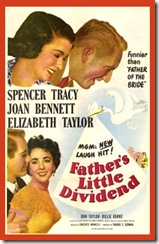 I hope all who celebrate are having a lovely Easter Sunday, and for those who don’t I hope they have a joyous day as well.
I hope all who celebrate are having a lovely Easter Sunday, and for those who don’t I hope they have a joyous day as well. 


